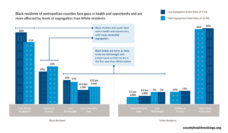Cardiovascular disease is the leading cause of death in the United States and very recently has been a major contributor to mortality from Covid-19 infection. Past research has documented large disparities in heart health by income and race-ethnicity, with poor and minority individuals facing many disadvantages. Little is known about how heart health plays out across the lifespan for females and males and how much those patterns reflect socioeconomic status versus other factors stemming from systemic racism.
These facts beg two questions: 1) At what ages do racial-ethnic disparities in heart health emerge and do they widen or narrow as people age? And 2) To what extent do disparities in SES account for racial-ethnic differences in heart health?
To answer these questions, we analyzed 18 years of pooled data (1999-2016) from the US National Health and Nutrition Examination Survey (NHANES) to document age- and gender-specific racial-ethnic differences in the prevalence of diabetes, high cholesterol, hypertension, obesity, and metabolic syndrome. Using data from over 51,000 people age 12 to 69 who identified as non-Hispanic white, non-Hispanic Black, or Hispanic, we documented the prevalence of the five cardiovascular conditions by race-ethnicity with and without adjusting for income, education, and wealth (home ownership, and family assets/savings).
The most striking finding was that racial-ethnic differences in heart health emerge early in the life course and stay relatively constant thereafter, and few can be attributed to socioeconomic status.
For most cardiovascular conditions and risk factors, Black people have higher rates than whites. Notable exceptions were for Black males, who have lower rates of high cholesterol and metabolic syndrome than white males and similar rates of obesity. Hispanic people have rates of high cholesterol, hypertension, and metabolic syndrome that are similar to those of whites but Hispanic women have higher rates of diabetes and obesity than white women.
The most striking finding was that racial-ethnic differences in heart health emerge early in the life course and stay relatively constant thereafter, and few can be attributed to socioeconomic status. We also found that Black-white differences in particular differ substantially by gender in a consistent pattern, with “whiteness” generally appearing to be more protective for females than males.
Overall, the findings from our study indicate that racial-ethnic disparities in heart health are rooted in early life conditions. These disparities do not appear to reflect differences in educational attainment and financial success. Rather, they seem to strongly reflect factors uniquely associated with race-ethnicity, such as experiences of racism, discrimination, and segregation. The larger disadvantage among Black females compared to males may reflect worse access to or quality of health care at relatively young ages (for example, reproductive health care), when most cardiovascular conditions and risk factors take root.
Our findings suggest an important role for policies that address systemic racism in health care access and quality, housing, schools, and neighborhoods. Narrowing racial-ethnic inequalities in cardiovascular conditions and risk factors will improve the heart health of all Americans.
Acknowledgement:
We gratefully acknowledge our colleagues and co-authors on the manuscript: Julien Teitler, Melissa Martinson, Rayven Plaza, and Nancy Reichman. This work was supported by funding through the National Institutes of Health, the US Department of Health and Human Services/Health Resources and Service Administration, and the Robert Wood Johnson Foundation.
Photo via Getty Images















